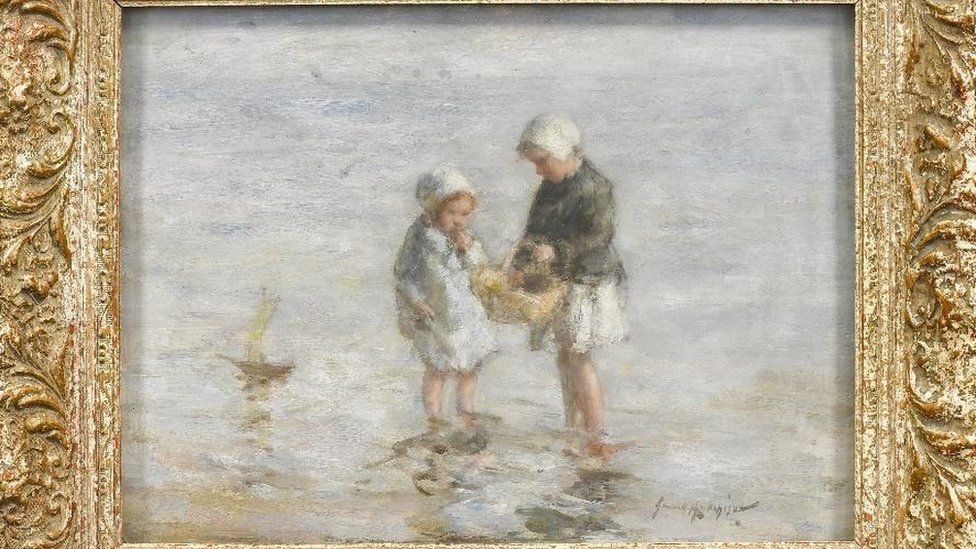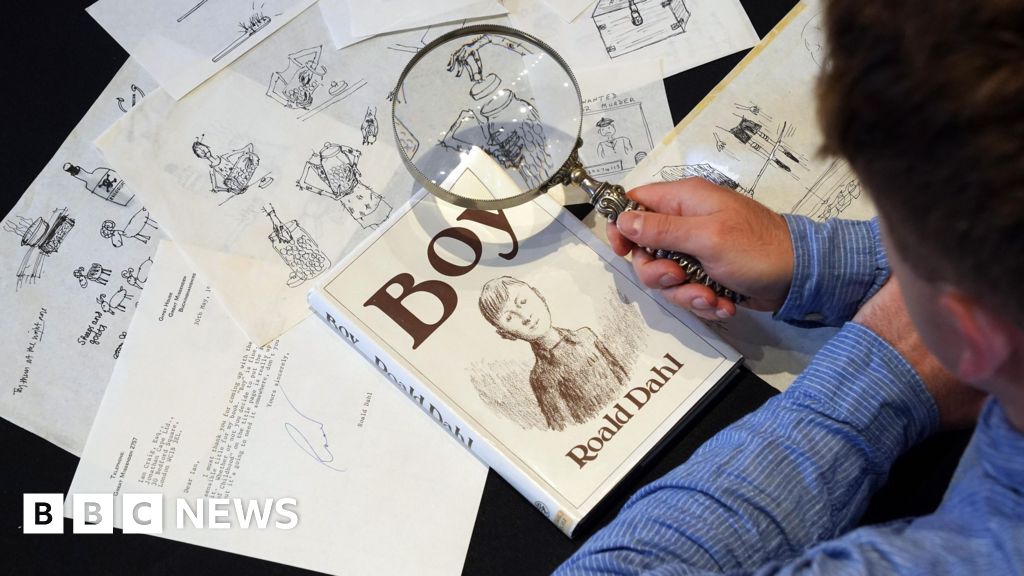ARTICLE AD BOX
 Image source, Glasgow Museum
Image source, Glasgow Museum
Children Wading, by Scottish artist Robert Gemmell Hutchison
By Carolyn Atkinson
Front Row, BBC Radio 4
A painting stolen during a museum heist in Glasgow more than 30 years ago has been found, after being put up for auction by an unsuspecting seller.
Thieves deactivated an alarm system and climbed up a ladder and through an upstairs window to break into the Haggs Castle Museum of Childhood in 1989.
They stole a cache of artefacts, some on loan from the world famous Burrell Collection.
And none of them has been seen since - until now.
Children Wading by Robert Gemmell Hutchison was found after being listed on the Art Loss Register (ALR), BBC Radio 4's Front Row programme has revealed.
Used by museums, auction houses, insurers, law firms and the police, the ALR describes itself as the world's largest private database of stolen art, antiques and collectables.
'Nazi-looted art'
It "is growing all the time", director of recoveries James Ratcliffe says.
"It's currently got 700,000 or more items registered on it that are somehow subject to a claim," he says.
"It's a range, from stolen material [and] Nazi-looted art, to antiquities.
"[Each year] we add about 30,000 or 40,000 items to the database, checking some 450,000 or 500,000 pieces against the database as they move through the art market, to see if they are subject to a claim before they go through further transaction."
And Mr Ratcliffe is expecting a very significant increase in the number of missing museum items being added in the coming weeks and months - because museums around the UK are auditing their collections, after revelations 2,000 items from the British Museum are missing, stolen or damaged.
Some of the British Museum's unaccounted art has now been identified and added to the ALR, BBC News has been told.
And last weekend, Wales' National Museum told BBC News it also had almost 2,000 items unaccounted for.
Image source, PA-EFE/REX/Shutterstock
Image caption,The Metropolitan Police has launched an investigation into the British Museum disappearances
Data gathered by the ALR and shared with Front Row programme reveals 65,000 items are currently missing from museums worldwide:
- 45,000 added to the ALR in recent times
- 20,000 linked to museums looted around World War Two
The painting in the Haggs Castle heist - which also included a priceless 16th Century jug and porcelain dolls - had been owned by an unsuspecting family who put it up for auction when selling part of their late father's estate.
Painted at Carnoustie in Angus in 1918, Children Wading depicts two young girls paddling along the water's edge on a warm summer's day, with a toy boat bobbing along behind them in a gentle breeze.
"This painting was registered on our database in about 2014, when Glasgow Museums were going through their records, looking for pieces that they could add to our database so that we could track them down," Mr Ratcliffe says.
"Nothing was seen of it until it turned up in November last year, at an auction house in North Yorkshire."
The ALR identified it as stolen. Tennants Auctioneers immediately withdrew it from sale. And the family said it should be returned to Glasgow Museums.
Image source, Glasgow Museum
Image caption,Glasgow Museums Resource Centre
Director Duncan Dornan says the painting was gifted to the museum in 1960 and it is thrilled to have it back.
"We're delighted to have a work returned, even though the theft was a very long time ago," he says.
"The pain of it still persists - and there's a loss to the public in Glasgow.
"We were sorry to lose it and delighted to be able to recover the work subsequently, using the Art Loss system.
"It is a charming depiction of children at play, which is obviously why it had been deployed in the Museum of Childhood at the time."
Paper records
Glasgow Museums has been modernising the way it stores and catalogues its collections.
But in the 1980s, museum security systems were very basic, Mr Dornan says.
"Collection information was held on paper records," he says.
"For a collection of more than a million objects, that is a huge amount of paper.
"Since the turn of the millennium, Glasgow has invested very heavily in its museums, with a major programme of investment in new storage for the collection, which meant that we were able to move all of the objects into bespoke state-of-the-art storage facilities, and also a major audit process moved information on to digital database."
'Buy art'
Mr Ratcliffe says it is not unusual for items to surface once in a generation.
"This is what happens a lot of the time with art which is stolen, because normally, if you're just a normal member of the public, you buy art and then you keep it.
"You've bought it because you like it and you want to keep it on your wall. And usually, it will stay there for the rest of your life.
"It's only really then, at the end of your life, that it's likely to reappear on the market."
Good-faith purchaser
Rosie Adcock, from law firm Boodle Hatfield, says: "In this situation, obviously, the Art Loss Register worked well and the family agreed, morally, to return the artwork.
"However, under the law, if a good-faith purchaser - so that's somebody who bought the artwork in good faith and without knowledge of the theft - bought the artwork more than six years ago, then in the eyes of the law, they are now the owner of that artwork.
"The original owner will not have a claim against that person anymore, because more than six years has passed.
"The original owner does still have their claim against the thief. And although they won't get their artwork back, they can claim against them for the value of that artwork.
"But obviously this depends on identifying who that thief is, issuing proceedings against them, and hoping that there'll be good for the money at the end of it."
'Very satisfying'
Mr Dornan is now hoping some of the other 20 or so items still listed as lost or stolen may eventually turn up.
"It's very satisfying to see your work wrongly taken from a public collection returning to the collection," he says.
"It is both good that the work returns to the people who want it, and makes it available for the public to enjoy.
"But it's also really good that these systems in the art sector work effectively and actually result in a positive conclusion."

 1 year ago
38
1 year ago
38








 English (US) ·
English (US) ·